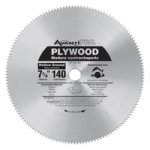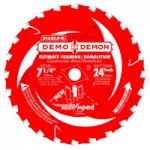When it comes to circular saw blade types, there are a ton of options, each designed for various cuts, materials and finishes.
It is easy to become confused and spend your money on the wrong one. For example, using a crosscutting blade for rip cuts will not only produce an undesirable result but can be dangerous.
We want to make sure this doesn’t happen!
The purpose of this article is to teach you what you need to know about circular saw blades. We will break down their anatomy, explore different types and explain what you should look out for when choosing the right blade.
Quick break down of woodworking blades

Ripping blades are used to cut along, or parallel to, the wood grain. They have few teeth to allow for large gullets which are required to remove material for a quick cut.

Usually featuring around 100 teeth, fine tooth blades are used to create an extra smooth finish.
Crosscutting Blades:
Because cutting across the grain is harder than cutting along it, these blades feature more teeth for a slower feed rate and smoother finish.

Used to cut plywood, plastics and oriented strand board (OSB). They can feature as many as 140 teeth for a smooth cut.

This is the go-to blade when you have some tough material that needs cutting. They have few teeth which allow them to cut through anything you put in front of them with ease. Don’t expect a smooth finish though!


As the name suggests, these blades are great multi-purpose options for both ripping and crosscutting many types of wood including laminated and plywood.
Other non-woodworking blades are available such as diamond blades which are used to cut tile and masonry.
Understanding saw blades
The cutting ability of a circular saw blade is all about its teeth. But before we look at how the number of teeth and different configurations affect the cut, I think it’s important we understand their anatomy.
Anatomy of a Circular Saw Blade & Terminology
Arbor Hole: A blade needs to be attached to the rest of the saw in some way. This is done via a shaft that extends from the assembly of the saw to create what we know as the arbor. The arbor, which is driven by the motor, rotates the blade once it is slotted into place.
Shoulder: The main bulk of the blade is known as the shoulder and is little more than support for the main feature, the teeth.
Bevel: This is what gives the teeth their shape. They can feature zero, one or two bevels. Bevel types can vary from tooth to tooth on any given blade.
Kerf: Refers to the thickness or width of the cut the blade makes as it cuts through the material. This can also relate to the thickness of the blade.
Hook Angle: The hook angle refers to the direction in which the teeth are angled. A positive hook angle is where the teeth lean in the same direction of the rotation of the blade. Great for fast and aggressive cuts. A negative hook angle refers to when the teeth tip away from the direction of the blade rotation. When the teeth are aligned with the center of the blade, this is known as a zero-degree hook angle.
Gullet: The space between the teeth that clears the chips away from your workpiece. During crosscuts, the chips produced are smaller and so don’t require a large gullet. Gullets on crosscutting blades are also purposely made small to slow down the feed rate which can often be a problem. Rip cuts, however, tend to produce larger chips. This is why a rip cutting blade will feature a deeper gullet for more efficient removal. Combination blades that are used for both cross and rip cuts will have small and large gullets. Large for clearing out chips and small to impede feed rate.
Expansion Slots: Spaces that allow the blade to expand and contract when it gets hot during use to prevent warping.
Number of Teeth
Circular saw blade can feature anything from 14 up to 140 teeth! The more teeth on a blade, the smoother the cut. Fewer teeth are great for the quick removal of material. For example, a crosscutting blade needs to leave a smooth finish across the grain which is why they normally have up to 80 teeth. This also results in a slower feed rate as touched on above.
If you have some thick material that needs cutting, a blade with as little as 14 teeth is your best bet. These blades are designed to rip through the toughest of materials with ease. However, avoid using blades with fewer than 24 teeth on thin sheets of material, you will destroy it!
Blade Tooth Combinations
The positioning and shape of the tooth on a circular saw blade determine how it cuts. Teeth configuration will decide if the blade is to be used for making crosscuts, rip cuts, cutting laminate etc. Here are some different teeth configurations.
Flat Top (FT): Predominantly used for ripping soft and hardwood. As wood is less likely to chip when being cut along the grain, the flat top of a rip blade is designed to briskly remove material and make faster cuts.
Alternate Top Bevel (ATB): Ideal for making smooth crosscuts into natural woods. The bevel of the teeth alternate left and right, leading to a cleaner cut than a blade with a flat top teeth configuration.
High Alternate Top Bevel (Hi-ATB): A Hi-ATB blade is for those occasions you need to perform extra-fine crosscuts. They are also useful when working with melamine surfaced materials which are susceptible to chipping.
Alternate Top Bevel Raker (ATBR): Is a combination blade
Triple Chip Grind (TCG): This teeth configuration is designed to cut hard, abrasive material such as plastic, laminate and non-ferrous. Teeth alternate between high trapeze tooth and flat raking tooth.
What to consider when buying a circular saw blade
Choosing the right blade is important. The wrong one will not only leave an undesirable result but can be very dangerous.
When choosing your blade there are many factors you must take into account, let’s explore them!
Blade Diameter & Arbor Size
Before looking at anything else, you must consider blade diameter and arbor hole size. The blade must fit snug to the arbor for concentricity and transmission of power so it is important you get the correct size. Typically, as the size of the blade increases, so does the arbor hole. Refer to the table below as a guide.
| Saw Type | Blade Size | Arbor Hole Size |
|---|---|---|
| Small Woodcutting Saws | 3’’ | ¼’’ |
| Small Woodcutting Saws | 6’’ | ½’’ |
| Handheld Saws (most common) | 7-1/4’’ | 5/8’’ |
| Powerful Stationary Saws | 12’’ – 16’’ | 1’’ |
Blade Type
As we went in-depth earlier, let’s try and simplify things. Do you want a finer and more precise cut? Get a crosscutting blade. If you’re making rough cuts, go with a ripping blade. Also, don’t forget to take into account the type of wood you intend to cut. Trying to cut a sheet of plywood with a ripping blade is not a good idea.
Blade Coating
Some blades are coated to maximize their performance and prevent corrosion. The coating will reduce friction which leads to less heat buildup during cutting, reducing the chance of burn marks on your wood.
Price
We can’t end without mentioning price, especially when the cost of circular saw blades can vary so much. You might be able to save some money on the saw you buy, but the blade is not an area to do the same! Cheap blades can warp, wear out quickly and increase the likelihood of an accident. Investing in good quality blades from trusted brands will save you both money and problems in the long run.
As you can see there is a lot that goes into finding the correct blade. We hope this guide saves you a lot of time and makes your decision much easier. Believe us, the result will be worth it!
Other Guides You Might Be Interested In
Best circular saws for the money

Reader Interactions